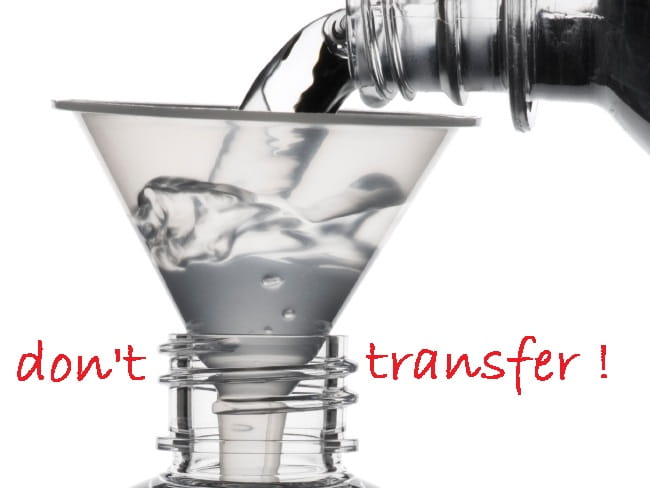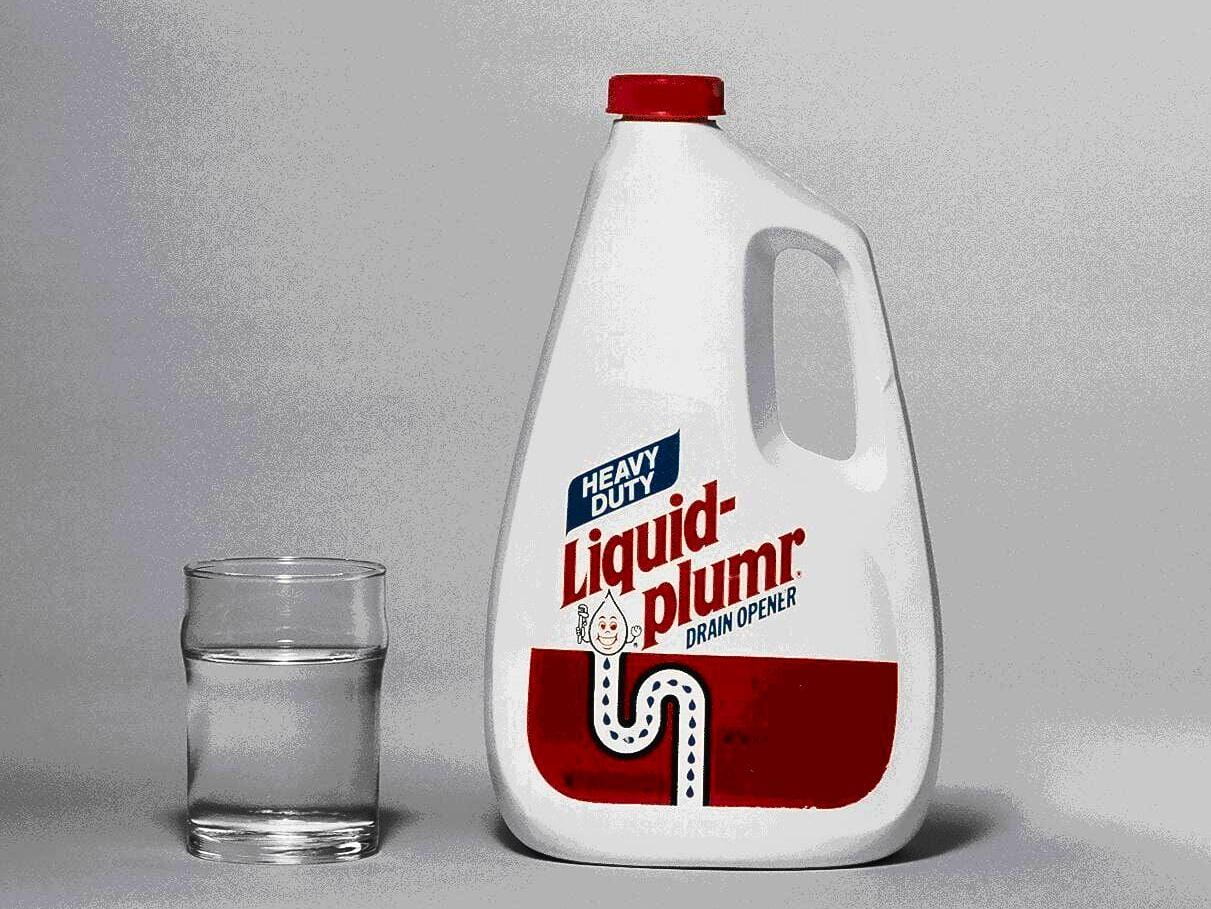Uh Oh...That Wasn't Orange Juice! Why Container Transfers are Dangerous

The Bottom Line
Transferring products from their original containers to unlabeled beverage or other containers happens all too often. Think only children mistake the contents for juice or soda? Not so! Adults unintentionally drink these poisons too. Sometimes the result is only throat irritation or vomiting, but sometimes the consequences are serious.

The Full Story
You just bought the economy size of a household cleaner. Saving money is a good thing! But it’s really inconvenient to carry around, so you transfer the purple liquid into a water bottle. That jug of windshield washer fluid is bulky and heavy. You put some in a soda bottle to keep in the car. The detergent used at your workplace really cuts grease and stains. Why not bring some home in a jar?
Potentially poisonous chemicals are found in almost every home. They might not be packaged for convenient daily use, inviting transfer into more user-friendly containers. By following simple precautions, the risk of poisoning can be reduced. The Environmental Protection Agency, among other regulatory bodies, stipulates safe labeling and packaging guidelines for such products. But it's ultimately up to the consumer to make sure these safety recommendations are followed.
Pretty colors, fruity scents: Brightly-hued cleaners with fruity aromas might make household chores a little more pleasant but, if not handled properly, these cleaners can be mistaken for beverages by unsuspecting children and adults. Researchers at the Texas Poison Center found 94 cases in just 4 months including unintentional consumption of a household cleaning product with food-related colors and scents and with images of fruit on the label. Scientists have a name for such products –
food imitating products, or FIPs. One study suggested that when humans see FIPs, the brain gets a message that hygiene products are food. Marketing of cleaners to consumers can be difficult since people associate cleaners with hard work like scrubbing. But formulate the product to resemble a tasty drink or food, and the brain might interpret cleaning as more enjoyable. The risk of consumption increases considerably when such products are transferred into actual beverage containers.
It sure doesn’t taste like tomato juice... A reddish cleaner is placed in a juice bottle for convenience. A family member sees the bottle on the counter and puts it in the refrigerator. Aunt Mary assumes it is vegetable juice, takes a gulp, and starts vomiting. Once a container is in the refrigerator, it’s logically seen as meant for consumption and it is easily accessible to children. Never place non-food items in the refrigerator and always keep household cleaning products and food items in separate areas.
Leave it at work! Industrial cleaners are often more caustic and toxic than household cleaners. Transferring one of these cleaners into an unlabeled container and bringing it home can be a recipe for serious poisoning. Someone might unintentionally drink it and end up with internal burns or other injuries. Since the original container came from a workplace, medical personnel treating the patient frequently don’t have the product ingredient information to guide diagnosis and treatment.
Coffee, tea…or bleach? Placing cleaners in a drinking glass or cup might mean easier access for some cleaning jobs but could result in a visit to the nearest emergency room. Avoid transferring any non-food or beverage product into a container meant for drinking or eating. Tea looks a lot like some pine cleaners; clear bleach looks like water; citrus-scented furniture polish could look and smell like an orange drink; and caustic cleaner granules might look like sugar. Mmmmm – not!
Poison Control is standing by every day of the year. If you suspect any kind of poisoning, use the webPOISONCONTROL® tool or call Poison Control at 1-800-222-1222 at any time, 24 hours a day.
Mary Elizabeth May, RN, BA, MPH
Certified Specialist in Poison Information
Poisoned?
Call 1-800-222-1222 or
Prevention Tips
- Keep cleaning products in original containers - always!
- Leave original labels on all products and read the labels before using.
- If you must transfer a cleaning product to a smaller container for convenience, place a copy of the original label on the container as well as the number for Poison Control: 1-800-222-1222 and take special care to keep it away from children, especially if the container is not child-resistant.
- Store household cleaning products away from foods and medications.
- Keep household cleaners in cabinets with child-resistant latches.
- Never place non-food items in the refrigerator (there are some items, such as antibiotic suspensions, that should be refrigerated; make sure these are placed in a refrigerator area out of the reach of curious children and in their original containers).
- Don't bring cleaners or chemicals from work into your home.
- Be aware that food-scented cleaning products increase the risk that children and adults will swallow them unintentionally.
- Use dishes, glasses, and cups for food and beverage consumption only.
This Really Happened
Case 1: A 14-year-old boy swallowed liquid from an energy drink bottle. He then discovered that the bottle held windshield washer fluid containing methanol, a very poisonous alcohol. His family took him to the emergency room where the physician called Poison Control. Treatment with the antidote fomepizole, which inhibits the production of the toxic byproducts of methanol, was recommended. The boy was given fomepizole and hospitalized for 2 days until his blood methanol concentration fell to 0.
Case 2: A 43-year-old man drank a mouthful from an open can of soda in his refrigerator. He immediately vomited. Someone had brought home a strong industrial cleaner from work in the soda can, then someone else put the can in the refrigerator. The patient was taken to the emergency room complaining of throat and chest pain. The emergency physician called Poison Control for advice on toxicity and treatment. Poison Control advised that such cleaners might cause burns of the gastrointestinal tract even if no oral or throat burns were apparent, especially if it was an alkaline corrosive cleaner ingestion. No original container was available for identification, but the physician tested the liquid with a pH strip. It was extremely alkaline, probably an alkaline corrosive. The patient had a CT scan of his chest that showed a small perforation of his esophagus. He was admitted to the intensive care unit of the hospital and given medication to control his vomiting. He was initially not allowed anything by mouth, but his diet was gradually advanced over several days to clear liquids; ultimately, he was able to eat regular food again.
Case 3: A 35-year-old woman bought a 32-ounce bottle of pine cleaner. It was too heavy to carry around while cleaning so she put some in a drinking glass. Forgetting she had done so, she later thought the pine cleaner in the glass was tea, added more tea to it, and drank some. She immediately realized her error and called Poison Control. She was advised to sip fluids. When Poison Control checked on her a few hours later, she had followed that advice and was fine.
For More Information
References
Bakalar N. With a product for sudsing, some accidental sipping. New York Times. 2006, Oct 17:Sect. F:7.
Basso F, Robert-Demontrond P, Hayek M, Anton J-L, Nazarian B, Roth M, Oullier O. Why people drink shampoo? Food imitating products are fooling brains and endangering consumers for marketing purposes. PLoS ONE. 2014;9(9), e100368.
Holland RW, Hendriks M, Aarts H. Smells like clean spirit. Nonconscious effects of scent on cognition and behavior. Psychol Sci. 2005;16(9):689-93.
Miller MA, Levsky ME, Masneri DA, Borys D. Fabuloso: a cleaning product that tastes and smells good enough to drink [letter]. Pediatrics. 2006;118(2):848-9.
Poisoned?
Call 1-800-222-1222 or
Prevention Tips
- Keep cleaning products in original containers - always!
- Leave original labels on all products and read the labels before using.
- If you must transfer a cleaning product to a smaller container for convenience, place a copy of the original label on the container as well as the number for Poison Control: 1-800-222-1222 and take special care to keep it away from children, especially if the container is not child-resistant.
- Store household cleaning products away from foods and medications.
- Keep household cleaners in cabinets with child-resistant latches.
- Never place non-food items in the refrigerator (there are some items, such as antibiotic suspensions, that should be refrigerated; make sure these are placed in a refrigerator area out of the reach of curious children and in their original containers).
- Don't bring cleaners or chemicals from work into your home.
- Be aware that food-scented cleaning products increase the risk that children and adults will swallow them unintentionally.
- Use dishes, glasses, and cups for food and beverage consumption only.
This Really Happened
Case 1: A 14-year-old boy swallowed liquid from an energy drink bottle. He then discovered that the bottle held windshield washer fluid containing methanol, a very poisonous alcohol. His family took him to the emergency room where the physician called Poison Control. Treatment with the antidote fomepizole, which inhibits the production of the toxic byproducts of methanol, was recommended. The boy was given fomepizole and hospitalized for 2 days until his blood methanol concentration fell to 0.
Case 2: A 43-year-old man drank a mouthful from an open can of soda in his refrigerator. He immediately vomited. Someone had brought home a strong industrial cleaner from work in the soda can, then someone else put the can in the refrigerator. The patient was taken to the emergency room complaining of throat and chest pain. The emergency physician called Poison Control for advice on toxicity and treatment. Poison Control advised that such cleaners might cause burns of the gastrointestinal tract even if no oral or throat burns were apparent, especially if it was an alkaline corrosive cleaner ingestion. No original container was available for identification, but the physician tested the liquid with a pH strip. It was extremely alkaline, probably an alkaline corrosive. The patient had a CT scan of his chest that showed a small perforation of his esophagus. He was admitted to the intensive care unit of the hospital and given medication to control his vomiting. He was initially not allowed anything by mouth, but his diet was gradually advanced over several days to clear liquids; ultimately, he was able to eat regular food again.
Case 3: A 35-year-old woman bought a 32-ounce bottle of pine cleaner. It was too heavy to carry around while cleaning so she put some in a drinking glass. Forgetting she had done so, she later thought the pine cleaner in the glass was tea, added more tea to it, and drank some. She immediately realized her error and called Poison Control. She was advised to sip fluids. When Poison Control checked on her a few hours later, she had followed that advice and was fine.
